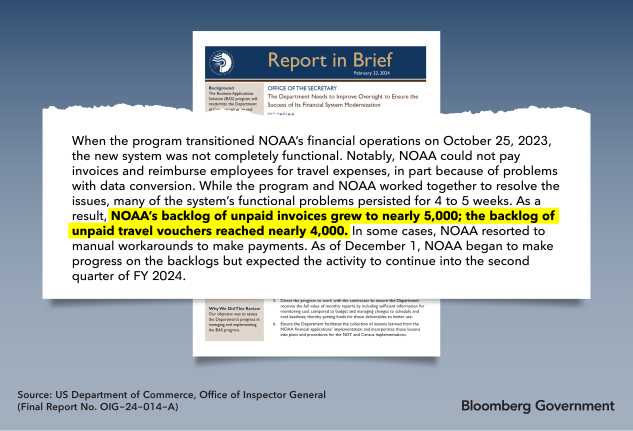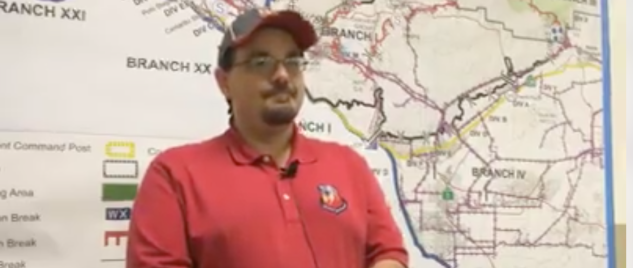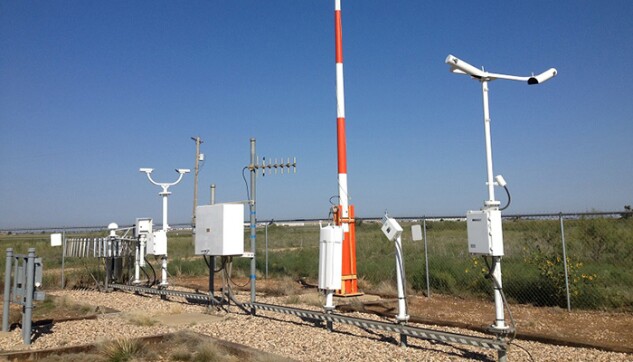- NOAA racked up thousands of unpaid invoices under new system
- Airport weather system was cut off; NOAA radio went down
A Georgia airport lost access to weather data for pilots. A radio transmitter vital to producing weather alerts for a tornado-prone part of Alabama went down. And two dozen National Weather Service employees were left waiting months to be reimbursed for on the job expenses, including travel to disaster areas.
It all stemmed from the rollout late last year of a new Commerce Department financial system, starting at the National Oceanic and Atmospheric Administration, that immediately stopped tens of millions of dollars worth of invoices and reimbursements from being processed for payment. The fiasco, which hasn’t been previously reported, has resulted in electric companies shutting off power to the agency’s equipment for nonpayment in at least two cases that could have proven dangerous, if not for a lucky streak of good weather.
NOAA is still working its way through thousands of delayed payments, and the union representing National Weather Service employees is pursuing a grievance on behalf of employees with unpaid expenses. Despite the failed rollout of what’s called the Business Applications Solution, Commerce officials plan to introduce it at the National Institute of Standards and Technology in fiscal year 2025 and the Census Bureau in 2026.
“Somewhere along the lines, someone in the federal government made a blunder here,” said Los Angeles-based meteorologist Rich Thompson, who waited for five months to be reimbursed $5,400 for expenses when he responded to northern California wildfires. “I’m not sure who or what, but somebody made a pretty big blunder.”
NOAA has been slow to work through the backlog. Officials told the Commerce Department’s Inspector General as of Dec. 1 they had paid about 1,000 of the delayed invoiced, totaling $84 million, and they “expected to address the remaining 4,000 invoiced by January 2024,” according to the report, which was published Feb. 22. But the problems persisted, and the backlog is expected to remain through the current quarter, according to the report.
Federal employees and local emergency-management professionals say they’ve been confused by what caused the breakdown. The inspector general report blamed “data mismatches.” Department of Commerce and NOAA officials declined to answer questions regarding the missed payments, including how many people are still waiting to get paid.
But NOAA spokesman Scott Smullen said the agency is working to fix problems with the Business Applications Solution system.
“The move to BAS is a necessary, but complicated transition that will improve the Department’s financial management operations over time. We are aware that several issues have arisen during the transition, including impacts to employees. We are working diligently to assess and resolve technical issues as quickly as possible. NOAA and the entire Department are committed to improving the processes around future implementation phases of the program and identifying lessons learned to inform those future phases.”
Those affected by the failures say they were lucky there wasn’t severe weather when NOAA facilities were shut down and meteorologists were unable to travel. They also credit good working relationships with local National Weather Service officials in helping to quickly resolve the critical outages, despite frustration with Commerce Department officials in Washington.
On Their Own Dime
When a hurricane hits or a wildfire spreads out of control, the National Weather Service calls Thompson. He packs up a laptop and camping equipment and rushes to the scene, where he advises emergency crews and keeps the public informed.
Last October, Thompson was sent to respond to the Smith River Complex, a series of wildfires that burned tens of thousands of acres in northwest California. He camped out at Ward Field, a small airport in Gasquet, Calif., advising firefighters on weather conditions each morning for two weeks. His expenses—including a rental SUV and a couple of nights at a hotel when a rainstorm came through —maxed out his government credit card.
Typically, Thompson would report his expenses, get paid, and pay off the charge card. This time was different. He waited for months, unable to pay the card without relying on his own savings.
“I’m not going to use my personal card for this,” Thompson said. “I’m a federal employee for over 30 years. I’m not going to do that.”
He finally got reimbursed last week, shortly after first speaking to Bloomberg Government for this story. Thompson said he never got an explanation for why the funds were held up, even after he was repaid.
“Obviously, they knew it was a major issue right off the bat, because nobody was getting reimbursed,” Thompson said.
The union representing National Weather Service employees filed a grievance in January, complaining that 25 employees were waiting on travel reimbursements dating back to August.
When the new system was put in place in October, officials told employees everything went well, without acknowledging that travel reimbursements weren’t going out, said JoAnn Becker, president of union that represents National Weather Service Employees.
“The memo said it was so fantastic, everything went great,” Becker said in a phone interview. “Meanwhile, my employees are saying, ‘What are they talking about?’”
‘They Shut the System Totally Off’
In Rome, Ga., the Richard B. Russell Airport lost access for a day in January to NOAA weather equipment that sends information to pilots.
John Carroll, the airport’s manager, said he had no advance notice of the shut-off. The Automated Surface Observing System is located at the airport and is managed by NOAA, he said. Pilots rely on it to get weather data when they’re taking off, or about 40 to 60 miles out before they land, he said. Fortunately, the weather wasn’t bad enough that day for the outage to matter much, he said. Otherwise, flights likely would have been rerouted, he added.
“They shut the system totally off, so the airport and the area would not have the benefit of this particular ASOS system,” Carroll said in a phone interview.
Carroll said he called NOAA’s Peachtree City office, and was told by officials there that the Georgia Power electric bill hadn’t been paid. The system was up and running the next day, Carroll said.
The power outage was a surprise, not only because the airport wasn’t given advance notice, but also because Carroll has a good working relationship with local National Weather Service officials, he said.
“It’s not how they do business,” Carroll said. “I do have a good relationship with them. And it was a surprise, as I did not know that they were switching vendors, nor that it would it affect me.”
Emergency management officials in Cullman, Ala., experienced the same surprise when the local transmitter for NOAA Weather Radio went down for about two weeks in late February.
The weather radio system is especially important in areas prone to tornadoes like Cullman, which is about halfway between Birmingham and Huntsville. Power had been cut to the local transmitter because federal officials hadn’t paid their electric bill for several months, said Tim Sartin, director of Cullman’s Emergency Management Agency.
As with the Rome, Ga., airport, there fortunately were no weather emergencies to prompt storm alerts during that time, Sartin said. But the outage shouldn’t have happened, he added.
“Say, in the middle of the night, there’s a storm alert coming through your radio — you don’t get alerted because the bill didn’t get paid,” Sartin said in a phone interview. “That could be detrimental to anybody.”
Eventually, Sartin asked
Officials at the National Weather Service’s Huntsville office “did everything humanly possible” to help, but it was “completely out of their control,” Sartin said.
“If the Department of Commerce would do what a normal citizen does and pay their stuff online instead of mailing a check, it’d probably help out a lot,” Sartin said.
‘A Very Bad Look’
The Cullman electric bill was paid at the local level, said Todd Barron, the meteorologist in charge of the Huntsville, Ala., National Weather Service office. But there was an unexpectedly long delay in the money coming out of the Treasury Department.
“Once everything was switched over back in October, it wasn’t a smooth system,” Barron said in a phone interview. “You had to push hundreds of thousands of transactions through this new system. The Department of Commerce kind of knew this going in. What we didn’t know was it was going to last as long as it did.”
The Huntsville office is caught up on payments and the new system is stable, Barron said.
Other agencies that implement the system should be upfront with contractors and vendors about the difficulty of switching to a new payment platform, he added.
“You can’t just say it’s the latest and greatest and it’ll be a seamless transition,” Barron said. “It’s going to be good, but there are going to be some growing pains.”
Thompson also said the National Weather Service tends to have strong working relationships with local officials and vendors, but he’s concerned the months-long delay in paying its bills will reflect poorly on the federal government.
“A federal agency can’t pay their electric bill or water bill or their janitorial service?” he said. “It’s a very bad look for a federal agency.”
To contact the reporter on this story:
To contact the editors responsible for this story:



